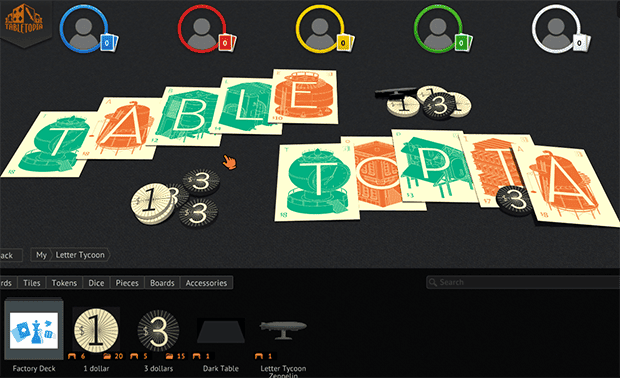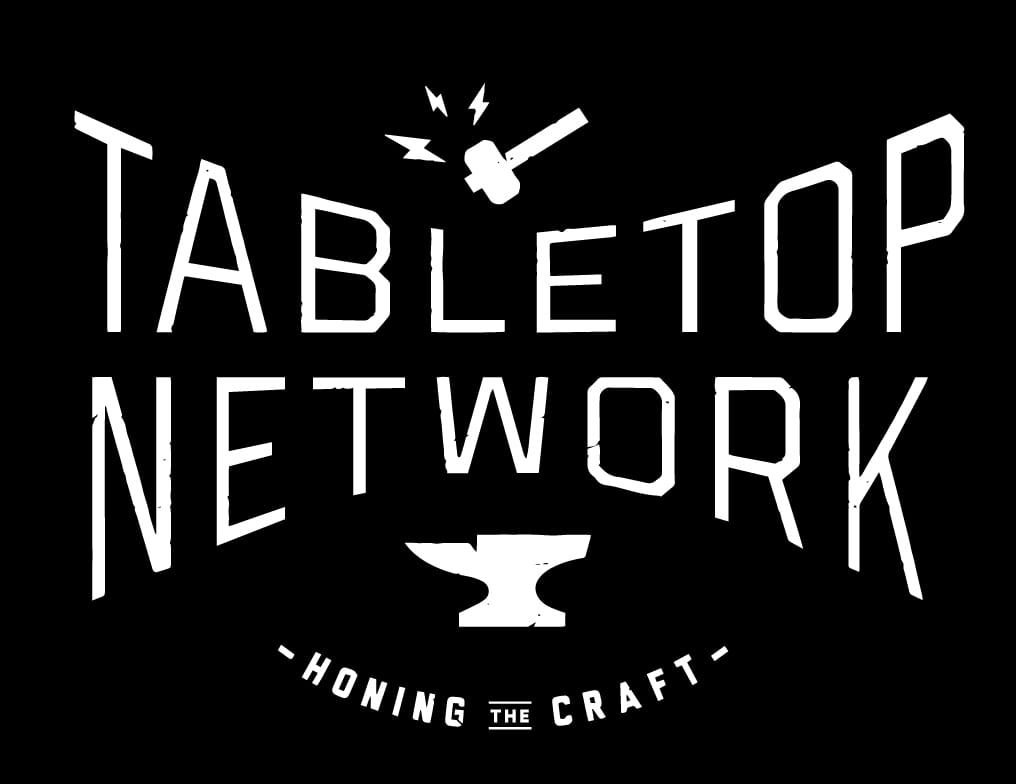
Tabletopia is a slick looking, inside-your-browser, online experience where board games go digital. It’s being supported by some big names in the industry due to a win-win relationship for publishers and designers, and already has very recognizable list of titles to play, such as Imperial Settlers, Terra Mystica, Tigris & Euphrates, Village and many more.
Tabletopia has a campaign on Kickstarter in its final hours as I write this, where you can back and get an early access pass and other perks to the system before it’s released.
I was keen to try this system out for the League, as we are spread around the country and are actively looking to make sharing prototypes and play testing game designs easier. Thanks to Tabletopia for a look at the system from the designer perspective. I tried my hand at a very rough early digitizing of Letter Tycoon.
I’m just getting started here, but I have seen enough now to know that the potential of this platform is HUGE.
For example, I’ve been working with Brad on the German edition of Letter Tycoon as we head to Spiel, and finding fluent German players at my own table has been difficult, but with this, crossing that distance and having me observe a game seems easy. In addition, a quick prototype can become a reality faster than ever before. I made some custom pieces within minutes.
ROUGH AROUND THE EDGES

The picture here is just joking with that header because this was my own user discovery that transparency matters when loading a circular token.
However, it does bring me to my point on the interface. It’s evolving. Some things aren’t there yet.
Examples:
- Dice beyond a D6. That d20 critical hit is going to feel so good!
- Textures – In the token above, I’d have to bake in the wooden surface of our physical pieces into the image files
- Custom 3D objects – I was surprised this wasn’t in already given that this is likely Unity (already 3D) on the backend.
Those are some bumps. The “create a game” screen is impressive with a link to BGG, opportunities to link to designer, artist, etc, but then again it’s missing minor data fields. Hey, no word game category. Ages listed jump from 7 to 10 to 16, and while it does have awards (!)… ahem, Mensa Select is not there (wink).
The forum is already full of suggestions and I have no doubt that the beta stage will capture a lot of the initial needs. The creators have already addressed upcoming features including the custom dice and 3D objects, as well as drafting, controlling when rules are broken, AI, voice chat and much much more.
THE LONG GAME
Bigger issues might be network connection and loading time. I went to watch some TV while I waited for the Imperial Settlers table to load in at 30MB in my browser, and the connection drop outs during upload of each Letter Tycoon card made the process a bit slow.
The system may not be good for learning a new game yet. It’s missing the person at the table to guides you through it, like when Chris is teaching a game. It’s not an app that delivers a programmed experience either. If you forget to take a coin or pay a coin, that’s on you – just like the actual tabletop. There might be an assumption because it is digital, that it would do things for you, or have help menus, but those aren’t there and at first it feels foreign.
IDEAL FOR DESIGNERS
They do have rules PDFs of course, but until the audio is in, and perhaps tutorial play, I see this as being more ideal for designers, and core gamers who know the game they are playing. For designers specifically, I think both the load times and the lack of rules/mechanisms beyond setup can be excused due to the upside to getting your game digital and accessible.
As with any brand spanking new technology however, and certainly one allowing outside folks in the beta, these things fall to the team making it, and their passion and dedication to get it done. Do I think this team is the team to solve them? I do. Not only do I see them active on their forums, on their Kickstarter, but they are taking in suggestions, creating new features, blogging tips, optimizing this for designers. I see this getting better and better.
THERE’S A LOT TO SEE – AND HEAR
First, there’s already 520+ public objects you can use. I felt like a kid in a candy store here. And I wonder too if I would start designing right in the system someday.

Of course, the meeples were expected. Something that surprised me was the custom sound effects you can put on card draws or meeple placements, etc. There’s other effects here too throughout the whole experience that just makes it go the extra mile. Publishers can add a custom soundtrack to the game night. You’ve got the physics of throwing chip on a pile, plus the sound of it, plus the shadow showing the distance. The level of polish is truly nice, and makes me want to play more games.
ADVANCED FEATURES
So while this is not an app that is taking care of calculations/math behind the scenes per se, this is just the beginning and tabletop processes are already being streamlined. Hidden information – there’s already one implementation your hand of cards, tiles or meeples which eliminates the screens. I think there’s coolness in the contextual right click menu, which can currently handle taking more than 1 card or dealing out any number of cards to everyone’s hand.

Counters take care of both bids and victory point counting. And I wanted to highlight two other cases I saw in the beta – the bag mechanism and the magnetic map.
The Bag.
Picking a random start player is as easy as putting markers in a bag and then right clicking to draw 1. You can put all the tiles in the game in here and deal 4 to each player, instantly putting them face up in each players hand.
The bag definitely makes things easier for digital tabletop.
The magnetic map
is a concept that Tabletopia details in their workshop documentation. Basically, you can highlight simple shapes on your board that you want pieces to snap to, either in position or orientation. This takes care of the fiddly nature of lining up cards exactly. It also allows you to indicate whether cards start face down or up, so if you are dealing out 4 more cards to a draw area and those should be hidden to start, this map makes it easy. The colors in this example indicate face up (red), face down (blue) and maintain state (green).
FINAL THOUGHTS
Well, I’m going to leave it here so you can comment, or go check out the Kickstarter and back this thing, so that you can then play me at Letter Tycoon with a backstage pass.
As a designer, I highly recommend. As a publisher, I will look into their income sharing model and see if it looks like the players flock to it, but I imagine with the support, momentum and passion this team has already, I think they can build a big community.
Back to my created game – this is where I managed to get to in just about 40 minutes. There’s a zeppelin, even though it’s not a 3D file, it’s a vertical token already. Just need some patents in there and we can buy the alphabet!

SEE IT IN ACTION!
Tabletopia featured some demo play recently. Jamey Stegmaier joined David Lutz for a twitch game of Viticulture, played inside Tabletopia. Yes, it’s cool on that many fronts! See for yourself if David can crush grapes with the best!








